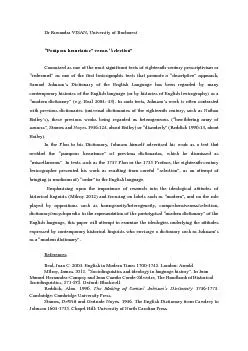PDF-Dr Ruxandra VI
Author : phoebe-click | Published Date : 2017-02-05
SAN University of Bucharest x201C Pompous luxuriancex201D versus x201Cselectionx201D Canonized as one of the most significant texts of eighteenth century prescriptivism
Presentation Embed Code
Download Presentation
Download Presentation The PPT/PDF document "Dr Ruxandra VI" is the property of its rightful owner. Permission is granted to download and print the materials on this website for personal, non-commercial use only, and to display it on your personal computer provided you do not modify the materials and that you retain all copyright notices contained in the materials. By downloading content from our website, you accept the terms of this agreement.
Dr Ruxandra VI: Transcript
Download Rules Of Document
"Dr Ruxandra VI"The content belongs to its owner. You may download and print it for personal use, without modification, and keep all copyright notices. By downloading, you agree to these terms.
Related Documents

